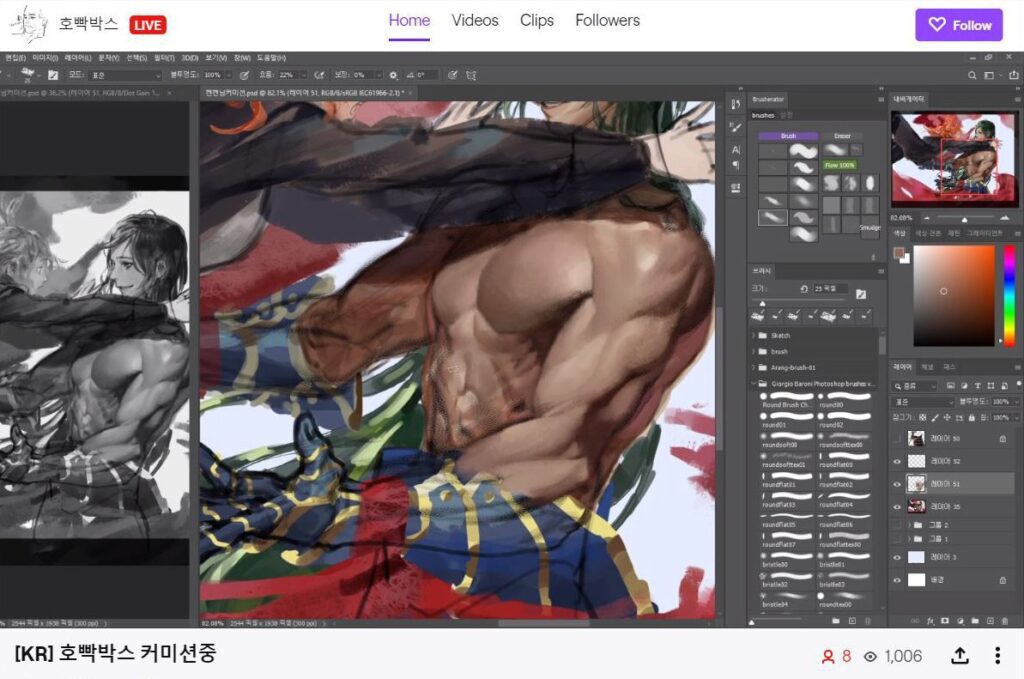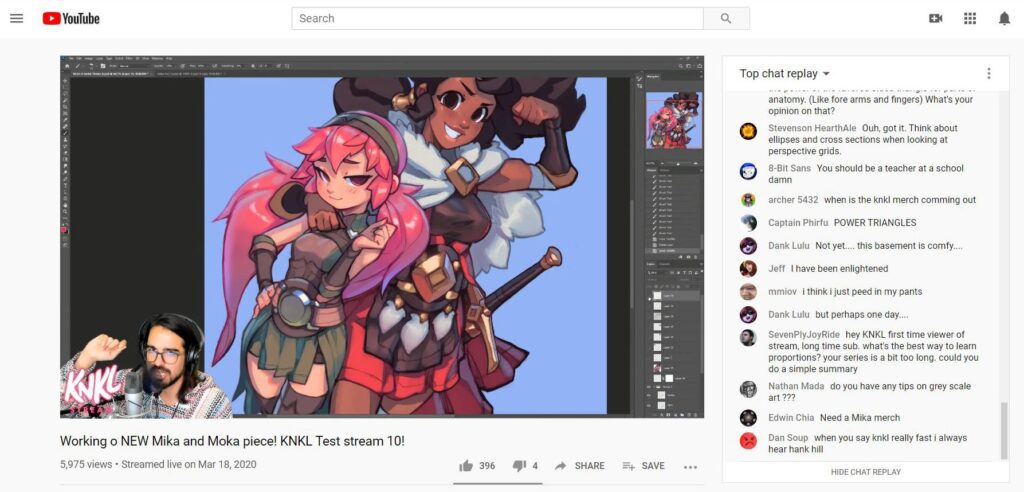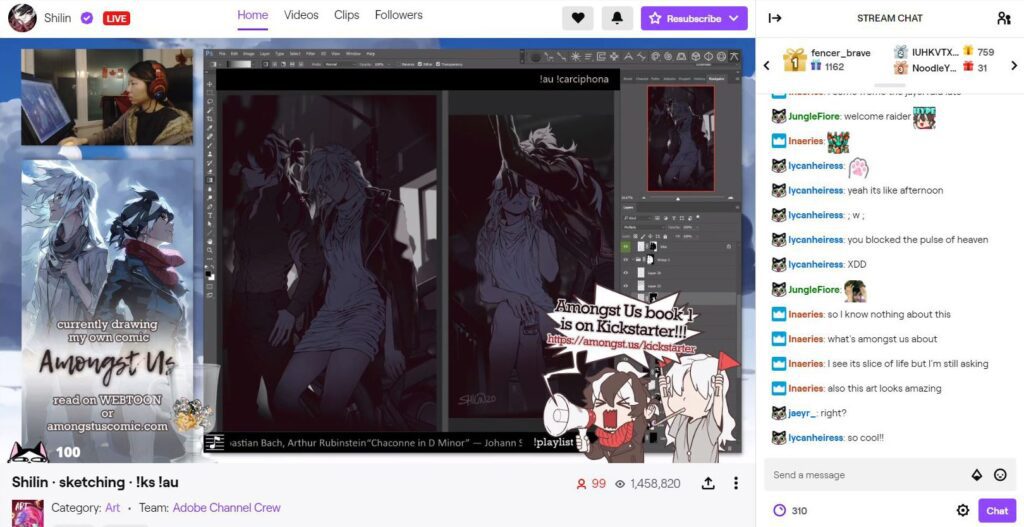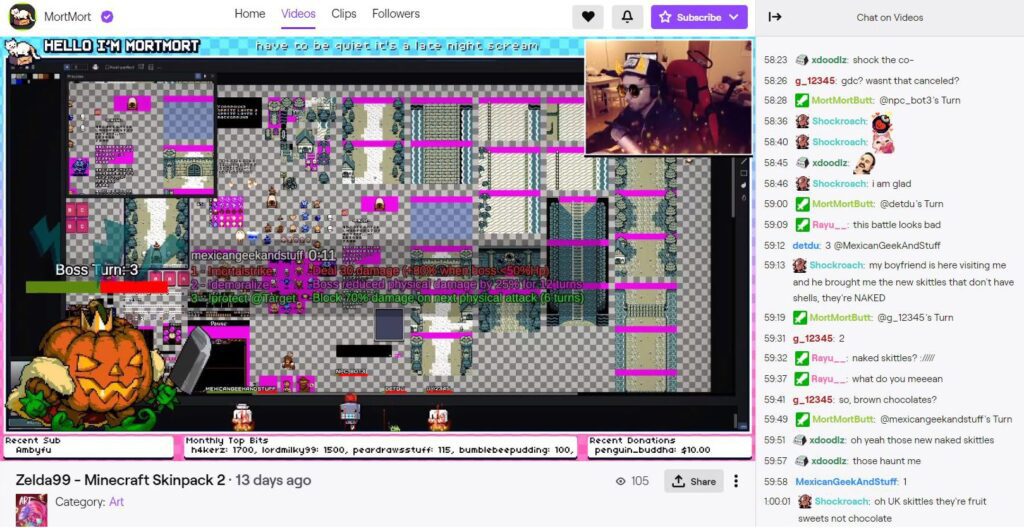3/20 Note: This was originally written in December, so it doesn’t reference the current state of affairs. For information on virtual artist alleys and livestreaming as an alternative to events, see my last article, Artist Resources: So Your Con Was Cancelled.
I moved to a larger room last month, which allowed me to rebuild my streaming setup that had been packed away for a year. That’s as good an opportunity as any to show you to set up your own from the beginning.
Like art on the whole, streaming is easy to get into, but deceptively hard to get good at. At the bare minimum, all you need is OBS and a computer:
The Barebones Setup


Boxbox909’s minimal stream: Just a Photoshop capture. Art this good can hold the attention on its own, though.
‘Puter
To be able to stream, it’ll need:
- And I5, i7, or i9 processor; or AMD equivalent.
- A graphics card.
Trying to stream with onboard graphics will usually result in Youtube-circa-2007 resolution and a framerate that has to be measured per hour. - At least 8 GB RAM. 16 recommended.
You can pull off 720P with 8GB. Any upgrades past that will allow you to run more programs smoothly while streaming.
At least 10/10 mbps. internet
Preferably ethernet for stability. If you have to use WiFi, getting a good external antenna helps, even if you’re using a laptop with a built-in one.
OBS
There are two major streaming programs, this and XSplit. OBS is by far the more common one, because it’s free and open-source.
There are two types of OBS as well: Regular and Streamlabs, charmingly nicknamed SLOBS: a reskin with a simplified interface that automates many of the processes Twitch streamers specifically use most, but at the cost of some of the more precise controls that regular offers.
SLOBS automatically detects your computer specs, screen resolutions, mics, and cams—where I had to manually add them in regular—sets your resolution and framerate to what your system can handle, and connects directly to your Twitch or Youtube accounts so you won’t have to piddle around with stream keys and server addresses.
Note: This is also its biggest flaw, though. If you stream through Restream or Picarto, it will erase your stream key every time you log in and force you to input it again. Find an app that’ll let you save it to your clipboard.
It lets you create bots and download themes that come with professional sidebars, popups, and sound effects in-app, although most are made for gamers, with energy-drink aesthetics that might not be what you want as an artist.
Personally, I resisted making the switch for years, but the minute I tried SLOBS, I realized it makes things 10x easier.
Note 2: if you work on 2+ monitors, I recommend you either stream in studio mode or learn the screen switching hotkeys, then transition through a holdscreen, so you won’t have to have the OBS window pop up in your stream every time you want to switch screens and cause that weird two-mirrors-across-from-each-other effect. You’ll know what all that means when you try it.
A platform
For art streamers, the big three are YouTube, Twitch, and Picarto.
YouTube
—Is YouTube, needing no explanation. You’ve probably watched it today. It has the most name recognition, but with several downsides.
- Unless you have an established channel, you won’t get drop-in viewers since the platform is so huge and labyrinthine they won’t find you just by browsing.
- It lacks some of Twitch’s networking and monetization features.
- They have the strictest rules and enforcement on playing copyrighted music in your stream. Where Twitch will just mute portions of your stream’s replay video and Picarto doesn’t have any policy on it, YouTube will block your replay videos in all countries, then take away your streaming privileges after enough strikes.


Kienan Lafferty draws characters from his upcoming comic Maid of Metal.
Twitch
—As you already know if you have any interest in becoming a streamer, is the gold standard for public livestreaming.


Shilin Huang working on her comic Amongst Us (on a Cintiq 21UX).
It used to have a reputation as being for gamers only, but just looking at who’s live now (8 PM EST on a Wednesday), there are not just visual artists, but a pizza cook, a cosplay harpist, a knifesmith, a couple decorating a Christmas tree, a woman doing tarot readings in a coffee shop, someone making fishing lures, a Filipino radio DJ, a cat camera, someone building a desk, a political Youtuber debating viewers, a storm-chaser tracking a blizzard outside Cleveland, someone streaming from her phone while shopping at Target, someone exploring a beach in South Korea, someone commenting on current events in Brazil, a dashcam from a road trip, a guy doing backflips, a drag queen doing her makeup, and a feed from the International Space Station; as well as OhNips, Lavender Towne, and the Small-Buteras all at once. (Although the Small-Buteras are playing video games.)
Anyway, there’s a relatively small but active community of digital artists who often support each other’s content. If you’re a regular viewer and commenter in other artists’ streams, they might just watch yours.
Picarto
…Is the Deviantart of the streaming world, with all the good and bad that entails. It’s dedicated to artists, with nothing else to be found there. It’s more libertine than the other two, which makes it popular with furries and experimental artists, and it’s the only one that explicitly allows NSFW content, so it’s the only game in town for erotic art.


It also allows multistreaming with premium accounts.
Occasionally a big-name comic artist or illustrator will drop in, too. Check, Please!’s Ngozi Ukazu sometimes draws pages there.
An audience
Unfortunately, Twitch stopped promoting their Creative section since it was proving less popular than gaming, so you can’t rely on drop-ins. (Although you couldn’t before, either.)
So you’ll need to promote your streams on social media.
There are loads of online guides to how to do this. Gleam.io’s the best and most complete one I’ve found.
If you’re brave enough to be comfortable with your personal friends watching you, you can post on Facebook, but bear in mind that they penalize the reach of outgoing links.
Being active on Discord servers helps tremendously: posting the links to community channels is a good way to get people who’ve seen your art before to drop in. I don’t recommend starting your own until you already have a big following. People purge their Discord servers much more mercilessly than their Twitter follows, and if you stop posting content regularly, expect them to disappear.
Inspiration
Watch and network with other art streamers. Not only can they clue you in to things you’d like to try on your own stream, they can be your biggest allies in growing your audience through hosts and recommendations.
A Wacom tablet
Accept no substitutes.
Find the perfect Wacom tablet for your “working from home” style and space





Wacom Intuos Pro Small
Proven, compact pen
tablet for drawing and photo editing. Perfect for small work surfaces.
Includes 2 months of Photoshop and Lightroom




Wacom Cintiq 16
Feature-packed pen display for next level illustrations. 16” screen fits any work space.
Includes up to 6 months of




Wacom Intuos Pro Medium
All the features you need for drawing, sketching and photo editing. Great tablet for more spacious surfaces.
Includes 2 months of Photoshop and Lightroom



Wacom Cintiq 22
Large 21.5” HD display perfect for creating detailed illustrations, paintings and animations.
Includes up to 6 months of
Optional but highly recommended
Many art streamers err on the side of too minimal. I’m not talking about bells and whistles, but the equipment that lets your viewers see and talk to you. It’s fairly common for creative streamers to deck their streams out with custom overlays, but neglect their viewers.
Streaming is a social activity, and ideally, the purpose isn’t to show off how good you are at art—you can do that with the finished picture—but to educate and engage. If you don’t keep viewers present, they’re likely to either tune out or more insidiously, mute you and minimize you, telling themselves they’ll check the piece’s progress later, then forgetting to do it. Your viewer count still shows them, but no one’s watching.
At the very least, you have to respond on chat, and unless you have a hard time multitasking, I recommend you walk viewers through what you’re doing as you draw, too. Watching a Photoshop brush wiggle around won’t help your viewers learn anything by itself, and the more benefit you can offer your viewers, the more you’ll hold their attention.


Lavender Towne’s stream, with a face cam, onscreen chat, Spotify widget, and subscriber info.
A mic
Comments are serviceable, but generally, streams where the artist is on mic hold people’s attention better. And if you hate the sound of your voice, getting a mic with good dynamic range will at least help: Unless you have nothing else at hand, don’t use a gaming headset, as that’s the most common cause of potato quality.
I personally use the Samson C01U Pro. It does everything you want in a microphone, capturing the full range of your voice with a nice, balanced sound.
The old standard Blue mics are fine, and can be very useful if you ever want to have multiple people on your stream or try your hand at podcasting sometime, as most of them have a knob that lets you switch from one-directional pickup to dual (front and back of the mic) or omni (whole room). Yetis sound somewhat muffled and Snowballs somewhat tinny compared to others in the same price range, though.
Here’s a good comparison of budget ones, and the reason I got the Samson.
I recommend you buy them used on eBay. You’ll save a ton, and it’s not like microphones go obsolete. Mine was about $50 with shipping.
Side note: If all you ever plan on doing is talking into it, a USB microphone is the most convenient. If you’re a musician too, you’ll want an XLR mic run through a USB interface so you can use it with an instrument cable.
You’ll also need something to hold it up with. Many come with built in stands, which are fine for people who don’t expect to have to move it during your stream, such as people who do all their work from one tablet at one desk. But myself, I do both digital and traditional, with a slanted drawing table next to my computer desk, so I have mine mounted on a boom arm.


It also helps to get a shock mount. First, they keep your mic from making a terrible noise when you bump the table, and secondly, the screw-on bit that holds your microphone into its default stand can fall off and get lost, where shock mounts attach by gripping the mic around its middle, so they work just as well without it. They come in multiple sizes, so look up your microphone’s diameter either in the manual or on Google.
A boom arm can attach to almost any microphone mount, so the main thing to worry about there is weight. Get one that’s rated to 1KG for most mics, or 1.5 KG if you have a Yeti, which are notedly heavier than most.
A webcam
It’s good to have an external one, because your laptop’s sucks.
Any 1080p Logitech is a good choice. Unless you have a beast computer with lightning-fast internet, you won’t be streaming in 4K, and either way, most of your audience won’t have the facilities to watch it.
If you work solely digital, you can use it as a facecam. Viewers like seeing streamers’ expressions and reactions. If you do traditional too, you’ll need one to suspend above your drawing surface. If you have the money and spare USB ports, you can get two and do both.


OhNips’ two-cam traditional art setup
There are also apps that let you use your phone as a webcam and feed it into OBS, but I can’t speak to how well they work.
Lights
Webcams are better than normal cameras at operating in low light, but they’re still clearer and faster with sufficient lighting. The kind of clamp lights you get at the hardware store, with daylight-balanced bulbs, are great for providing a lot of light very cheap, although they’re painful to look directly at, and I’m looking at finding an alternative to them, myself.
Or if you’re musician SceneOfAction, you can get 14 automated webcams and a complete stage lighting rig.
At least 3 USB ports
One for your webcam, one for your mic, one for your mandatory Wacom tablet. You might need two more for your mouse and your WiFi antenna. When I’m working traditional, I like to keep one open for my scanner as well.
If you have a desktop with room for extra USB cards, nice. If not, you’ll need a powered USB hub. It’s very important it be powered, or else your microphone and webcam won’t be able to draw power through it.
Music
The drawing process is quiet and slow-paced. More so than gaming streams, art streams need something for auditory interest besides the occasional comment. In fact, music is often a key part of their appeal, and they can be a great personal radio station for your favorite songs. …If you’re not on YouTube.
I use Spotify Premium. Any audio source works, but Spotify has gapless play between songs, allows crossfading (I prefer one of 4 seconds, just seems to work best across most genres and tempos), and can connect to several freeware programs that display the song info on your stream. Aiden Wallis’s Spotify Now is by far the best one.
Make sure to turn it down so it doesn’t drown your voice out.
Plus ultra
These are the above-and-beyond upgrades, for those who really want to set their streams apart.
Restream
Restream is a web host that gives you its own stream key, then rebroadcasts you to multiple platforms at once, including Twitch, Picarto, and Youtube, and 39 others. It also has a downloadable chat client that’s much lighter on your system than watching your streams in browser windows and flipping between them.
Themes
Some streamers like to deck out their whole page with a consistent brand. All the components can be bought or commissioned if you have the money, found for free if you’re dedicated, or DIY’ed if you’re hardcore.
Custom overlays
These look like wizardry, but they just boil down to frames that you add to your OBS window overtop everything else, so static ones are easy to make as transparent PNG’s. If you want something fancier but lack the UI skills, you can commission them on sites like Fiverr, or use online generators or downloadable kits.
Custom panels
The little boxes under your stream window with descriptions, links to your socials, and suchlike.
Starting/ending/away screens
Images or little looping animations you can play when you’re on the toilet.
Alerts
SLOBS lets you set custom boxes to pop up in the stream when someone follows, subscribes, or donates. It’s common for artists to make custom animations for them as easter eggs.
Side Animations
Some artists like to have little dancing characters or meme GIFs on loop to the side. I personally think they clutter the screen and distract from the art happening, but if you like them, by all means go for them.


Pixel artist MortMort, however, has the most impressive custom theme I’ve ever seen, to the point where it circles back around to being one of his main attractions. He has fully-animated characters on the bottom for every commenter, which can get into interactive boss battles, as seen here.
Bots
These automate some of your stream’s admin work. They’re useful for answering FAQ’s, handling rote moderation tasks, and dealing with the nastier parts of the internet without you having to personally interface with them. For example, you can set it to filter slurs and kick the commenters that use them.
SparkoCam and a DSLR
If you also do traditional art and your webcam isn’t doing a good enough job of picking up light pencil lines, or if you’re unusually vain and want your face to look perfect, you can use SparkoCam to output live video from a DSLR camera to OBS.
For your attachment, you can either position it on a tripod, or if you’re very dedicated to having a traditional art setup, you can bolt it to the wall or ceiling and get an arm that holds it in the right position, or build a giant rig over your drawing desk, but that’s obviously extremely far out of my scope. Helps a lot if your camera has a power cable.
And for the ultimate livestreaming spectacle (pound your hands on the table very quickly)…
Facerig/Adobe Character Animator
The ingenuity of our broadcasters never ceases to amaze. Check out @Scribbleh who is live right now!
LIVE ???: https://t.co/bQzPQxazg6 pic.twitter.com/HYLFvciSYd
— Twitch (@Twitch) February 2, 2017
Some streamers use mocap and a rigged character to make an animated avatar that matches their motions and lip movements. It’s not common due to the expense and complication, I just wanted to let you guys know it’s out there, because it’s insane.
Finally
Drawing is a quiet, contemplative practice with few noscopes or explosions (I’m not saying none, but few.) so it’s less thrilling to watch than someone dominating in Counter-Strike. As a result, art streams get fewer viewers than game streams, and are mostly watched by other artists, of whom there are fewer than gamers. I’ve never heard of an artist getting partnered with Twitch* who didn’t have an audience from somewhere else, like YouTube or a successful comic.
*Offered the ability to earn paid subscriptions and ad revenue.
As a result, creative streamers can’t be motivated by money or the possibility of fame. There has to be something you intrinsically love about the streaming process. It can be easy to give up. I did, for two years at one point.
The best thing about it is that it motivates you to actually draw because you feel like you’re being held accountable, and it makes the process of spending hours at the table less isolating. And the best way to motivate yourself to continue is to try to get your friends involved. If you can at least sometimes have them on with you, whether they’re in your physical room or on voice chat, it makes it much easier to press on when things are slow.
Good luck, and if this motivated you to start streaming, please let me know on Twitter or on my own channel.
About the Author
![]()
![]()
CS Jones is a Philadelphia-based writer and illustrator who hasn’t streamed in a couple months, himself, but found it a formative experience in his art career and will eventually start again. His Twitter and Twitch are @thecsjones, but his Picarto is @CSJones. He wishes he’d kept them consistent.






